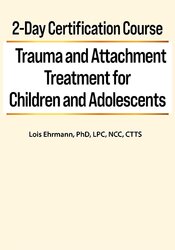

Becoming a Certified Child and Adolescent Trauma Professional will demonstrate your passion for and knowledge of treating traumatized children and adolescents.
This 2-Day Certification Course in Trauma and Attachment Treatment for Children and Adolescents will provide you with the essential skills, proven interventions, and state-of-the-art treatments you need to successfully treat your most challenging clients—children, adolescents and families suffering from trauma and attachment wounds.
Children’s neurology is impacted at the deepest levels of development resulting in emotional, behavioural and psychological problems. When the foundational blocks of attachment are fractured, you face therapeutic roadblocks—innate distrust of others, acting out, avoidance/shutting down, extreme reactivity, self-harm, affect dysregulation, substance abuse, poor boundaries—making successful treatment seem impossible to achieve.
Purchase this intensive 2-day certification training and learn the most effective tools and techniques to help children and families more fully engage in treatment, identify and express their emotions, manage disturbing thoughts and feelings, and achieve and maintain recovery.
Elevate your practice and improve your ability to:
Best of all, you can become a Certified Child and Adolescent Trauma Professional (CATP) upon completion of this course—at no additional cost to you—adding valuable skills and credentials to your resume.
Purchase today and show your clients and their families with trauma and attachment wounds, that you’ve taken the time and effort to effectively help them heal!
Certification Made Simple
In just three easy steps, you can earn your certification as a Certified Child and Adolescent Trauma Professional.
That’s it! No hidden fees. No catch. Just certification made EASY.
*Professional Standards apply. Learn more at uk.evergreencertifications.com/catpuk
This online program is worth 12 hours CPD.
| File type | File name | Number of pages | |
|---|---|---|---|
| Manual - Trauma and Attachment Treatment for Children and Adolescents (39.31 MB) | 198 Pages | Available after Purchase | |
| Link | CATP Certification Details |

Lois Ehrmann, PhD, LPC, NCC, CTTS, is a trauma-informed and sensitive clinician who works with individuals and families who suffer from trauma, abuse and attachment issues. She is the founder of The Individual and Family CHOICES Program, a holistic trauma-informed counseling center in State College, PA, that has been providing cutting-edge trauma-informed therapy for over 10 years. Prior to that she co-owned a dual diagnosis outpatient counseling program called Counseling Alternatives Group for over 18 years. She is a Licensed Professional Counselor in both Pennsylvania and New Jersey and has been in clinical practice for over 30 years, specializing in trauma and attachment for over 22 years.
A Certified Trauma Treatment Specialist (CTTS), Lois is also an Approved Consultant and Certified Clinician in Eye Movement Desensitization Reprocessing (EMDRIA) as well as a Certified Internal Family Systems Clinician. Trained in IFS Levels 1, 2 and 3 as well as Somatic IFS, she has introduced the IFS model to the children and families she works with, as well as groups of parents of traumatized children and to professional healers who work with traumatized families. Lois is a Registered ATTACh Clinician, Certified Attachment Focused Family Therapist/Consultant and an Approved Clinical Supervisor (NCE). In addition, she is a trained neurofeedback clinician and trained in clinical hypnosis.
Lois is a sought-after trainer both locally and nationally and is also an adjunct assistant professor in counselor education and supervision at PSU. She has presented nationally for many years for the National ATTACh Conference and until very recently served on that organization’s board of directors. Lois has also presented annually for the Internal Family Systems Conference specifically focusing on the use of IFS with children and families struggling with attachment issues.
Lois is the co-author of a book on best practices in attachment therapy and has self-published books for children and their parents on attachment and Internal Family Systems concepts. She was the lead researcher in the development of the Internal Family Systems Adherence Scale for the Internal Family System Foundation.
Attachment Theory and Attachment Therapy
Neurological Impact of Trauma and Attachment
Indicators of Trauma and Attachment Disruption
Assessments for Trauma and Attachment Wounds: Case Studies and Video Sessions
Translate Trauma and Attachment Goals into SMART Objectives
The Integrated Attachment and Trauma Timeline Strategy (IATTS): Help Children and Families Unpack Their History
TECHNIQUES WITH CASE STUDIES: PUTTING IT ALL TOGETHER WITH PRACTICE TIME!
A Child Who Had No Safety
When Traumatized Children are Broken into Many Parts
Full of Rage with No Where to Go
Parts that Children Wall Off
The Rage that Comes from Physical Abuse
When Parents and Children Both Have Activated Parts
Protecting Sibling and Self in Foster Care
Repair the Fracture with Adoptive Parents
Other Trauma-Specific Evidence-based Treatment Modalities
Satisfaction Guarantee
Your satisfaction is our goal and our guarantee. Concerns should be addressed to info@pesi.co.uk or call 01235847393.
Please wait ...